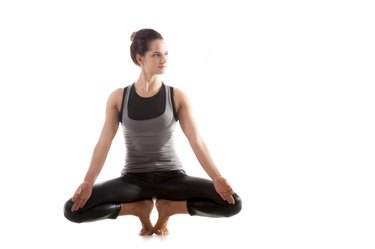
You have numerous foot tendons, but the one that most commonly causes pain is the Achilles tendon. Your Achilles tendon attaches your calf muscle to your heel bone. If the back of your heel hurts when you squat, Achilles tendonitis is the likely culprit. You are more apt to feel this pain if you are not warmed up or if you squat down first thing in the morning. If caught early enough, self-care is usually enough to remedy the situation. However, if your pain is persistent, or if it is severe, you need to consult a doctor immediately.
Squat Exercises
Video of the Day
When you perform the squat exercise incorrectly you are at risk for developing Achilles tendonitis. To do a squat correctly, start with your feet slightly wider than hip width apart. When you squat you need to monitor your feet, knees and ankles. Make sure your feet don't move, don't let your ankles collapse in or out and keep your knees aligned over your second toe. While your goal is to lower yourself until your thighs are parallel to the floor, you need to stop your downward motion if your heels begin to come off the floor. You push your feet into the floor through your heels when you rise. Concentrate on not holding your shin bone too vertical during the squat, which is a common tendency. Doing so makes you lean your torso too far forward. When you do a proper squat your torso and shin bones are parallel if viewed from the side. Practice proper form by looking in a mirror as you shift your shin bones forward and keep your heels on the floor.
Video of the Day
Overuse Injuries
You don't have to be a weight lifter to develop Achilles tendonitis and subsequent pain when you squat. In fact, most of the time a strained Achilles tendon is due to overuse. If you are a runner who is incorporating hills into your regimen or a hiker who traverses uneven terrain, you also are at risk. The same goes for long-distance cycling or amping up your aerobics routine. Jumping and other intense exercise activities also increase your chances of suffering this injury. Wearing improper shoes and exercising before you've adequately warmed up further ups your risk. In athletes, about 10 percent of the pain in your lower extremity is likely to be in the Achilles tendon, notes Christine Dobrowolski, author of "Those Aching Feet." However, other areas of your foot may be affected. You'll feel peroneal tendonitis on the outside part of your foot. As with Achilles tendonitis, the peroneal variety is usually an overuse issue. Posterior tibial tendonitis affects the tendon along your inside arch. You are likely to experience this if you if you have flat feet and fallen arches, and any type of activity is likely to affect you.
Care
If you have pain when you squat due to Achilles tendonitis you can do something about it. First you need to stop the activity that is causing it, whether it's weight lifting or running or something else. A full two weeks is optimal, but five days is sometimes enough to help. Ice your tendon twice daily for 20 minutes and take anti-inflammatory medicines like ibuprofen. Also perform calf stretches with your front leg bent and your heel stretched out. Stretch until you feel a slight pain and then back off. Don't overstretch, such as hanging your heel off a step, because it can worsen your condition. When you return to your activity do so gradually. Taper back anytime you start to get pain. In all, your tendonitis will take about six weeks to heal. Your doctor can advise you on whether heel lifts, orthotics or other options are likely to improve your condition.
Prevention
Be proactive to prevent foot pain when you squat. Yoga is one great tool because it improves flexibility and strength and reduces inflammation in your feet. Standing poses such as mountain pose also can help you gain better awareness of your feet and how you stand on them. This will help you distribute your weight more correctly in everyday life. Distributing weight evenly across your feet is necessary for proper alignment, which helps prevent foot pain. Increasing your activity level gradually and cross training, so that you alternate high impact activities like jumping and running with low impact activities like swimming also is helpful.
- “Those Aching Feet”; Christine Dobrowolski; 2005
- “Yoga Journal” magazine; Happy Feet; Melanie Haiken; August 2006
- “American Medical Association Handbook of First Aid and Emergency Care”; American Medical Association; 2009
- MayoClinic.com: Achilles Tendonitis
- MayoClinic.com: Achilles Tendonitis -- Prevention
- American Council on Exercise: Dumbbell Front Squat
- University of Michigan: Achilles Tendon Problems
- Foot Physicians: Achilles Tendon
Is this an emergency? If you are experiencing serious medical symptoms, please see the National Library of Medicine’s list of signs you need emergency medical attention or call 911.